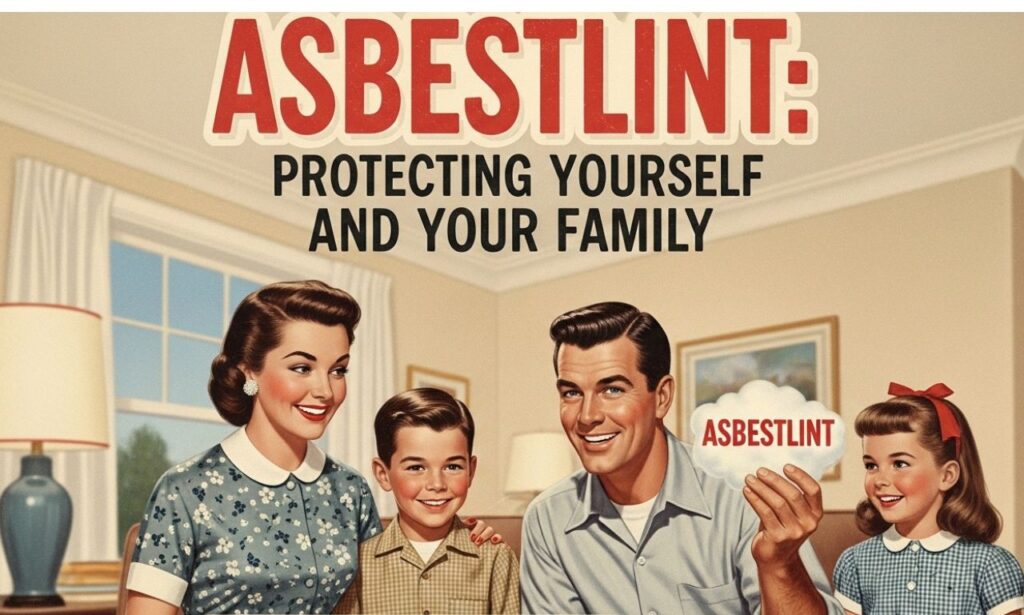Asbestlint is a word that often triggers concern. This naturally occurring mineral was once hailed as a miracle material due to its fire-resistant properties. However, it soon became synonymous with danger and health risks. The hidden threat of asbestos can lurk in homes built before the 1980s, putting families at risk without their knowledge.
Among the various forms of asbestos-related products, asbestlint—an asbestos-containing fabric used for insulation—is particularly concerning. Understanding what asbestlint is and how it can affect your home is crucial for safeguarding your loved ones.
In this article, we’ll explore the history and dangers of asbestos, focusing on how you can protect yourself and your family from potential exposure. Whether you’re renovating an old home or just curious about this hazardous substance, we’ve got you covered with essential information that everyone should know. Let’s dive into the world of asbestos together!
What is Asbestlint?
Asbestlint is a specialized type of tape designed for sealing and managing asbestos-containing materials. This product plays a crucial role in preventing the release of dangerous asbestos fibers into the air.
Made from durable, non-porous materials, asbestlint provides an effective barrier. It’s commonly used during renovation or demolition projects where asbestos might be present.
The tape adheres well to various surfaces, ensuring that it remains securely in place. This helps minimize exposure risks while work is being conducted.
Using asbestlint correctly can make a significant difference in safety measures. It’s important to follow guidelines when applying it to maintain its effectiveness.
For homeowners dealing with potential asbestos issues, understanding what asbestlint is can empower them in their efforts to protect themselves and their families from harmful exposure.
History of Asbestos Use and Regulations
Asbestos has a long history, dating back to ancient civilizations. The Greeks and Romans valued it for its fire-resistant properties, using it in textiles and building materials.
In the 19th century, industrial applications flourished. As factories expanded, so did the use of asbestos in insulation, roofing, and floor tiles. Its affordability made it a popular choice among builders.
However, awareness of its dangers began to surface by the mid-20th century. Scientific studies linked asbestos exposure to serious health issues like lung cancer and asbestosis.
Regulations started emerging in response to growing concerns. By the 1970s, countries began enacting strict guidelines around its use and removal. Many nations banned or severely limited asbestos products altogether.
Yet remnants of this hazardous material still linger in older buildings today. Ongoing vigilance is essential for public safety regarding any potential risks from historical usage.
Health Risks Associated with Asbestos Exposure
Asbestos exposure is linked to serious health issues. When fibers are inhaled, they can become trapped in lung tissues, leading to inflammation and scarring.
One of the most severe conditions associated with asbestos is mesothelioma. This rare cancer primarily affects the lining of the lungs and abdomen, developing decades after exposure.
Additionally, prolonged contact can cause asbestosis—a chronic respiratory disease that results in difficulty breathing and persistent cough. Symptoms may take years to manifest but worsen over time.
Lung cancer is another critical risk factor for those exposed to asbestos. The combination of smoking and asbestos significantly increases this danger.
Even secondary exposure poses risks. Family members might inhale fibers brought home on clothing or hair from someone who worked in an environment containing asbestos materials.
How to Identify and Test for Asbestos in Your Home
Identifying asbestos in your home can be challenging, especially since it often lurks behind walls or under flooring. Start by examining materials commonly associated with asbestos, like old insulation, ceiling tiles, and floor coverings.
If your home was built before the 1980s, it’s wise to err on the side of caution. Look for deteriorating materials that may release fibers into the air. Keep an eye out for frayed edges and visible wear.
Testing is crucial if you suspect asbestos presence. Use a DIY kit available at hardware stores or online; however, these can yield variable results. The safest option is to hire a professional who specializes in asbestos inspection.
Professionals have access to accurate testing methods and safety protocols. They’ll collect samples safely without risk to you or your family’s health. Always prioritize thoroughness when it comes to identifying potential hazards in your environment.
Steps to Take if You Have Asbestos in Your Home
If you suspect there’s asbestos in your home, don’t panic. Start by avoiding any disturbance of the material. Asbestos becomes hazardous when disturbed and releases harmful fibers.
Next, assess the situation carefully. If it’s intact and undamaged, it may not pose an immediate risk. However, monitor its condition regularly for signs of wear or damage.
Consider hiring a certified professional to conduct an inspection. They can provide accurate testing and evaluate potential risks associated with the materials present.
If asbestos is confirmed in your home, don’t attempt to remove it yourself. This process requires specialized training and equipment to ensure safety for everyone involved.
Instead, consult with experts on next steps tailored to your specific scenario. They will guide you through safe removal options if necessary or suggest effective management strategies if removal isn’t feasible at this time.
The Importance of Hiring a Professional Asbestos Removal Company
Dealing with asbestos is not a DIY project. The risks involved are significant, and safety should always come first. Professional asbestos removal companies have the expertise to handle hazardous materials safely.
These specialists understand the regulations surrounding asbestos disposal. They know how to navigate local laws while ensuring compliance. This minimizes legal risks for homeowners.
Moreover, professional teams use advanced equipment designed specifically for safe containment and removal. Their training prepares them for potential hazards that an untrained person might overlook.
Hiring experts also protects your family’s health. Asbestos fibers can linger in the air long after they’re disturbed, posing serious respiratory threats if mishandled.
Involving professionals ensures thorough testing before and after removal, giving you peace of mind about your environment’s safety. Trusting trained technicians takes much of the burden off your shoulders during this challenging process.
Alternative Options for Dealing with Asbestos
When faced with asbestos in your home, there are several alternatives to consider. Encapsulation is one option that involves sealing off the asbestos material to prevent fibers from becoming airborne. This method can be effective if done correctly and provides a less invasive solution.
Another alternative is simply leaving it undisturbed, especially if the asbestos isn’t damaged or crumbling. Proper management includes regular inspections to ensure it remains safe over time.
Some homeowners opt for replacement materials instead of removal. This allows you to upgrade while minimizing exposure risks during renovation processes.
It’s essential to weigh these options carefully. Consulting with an expert will help you understand what’s best for your situation and ensure safety measures align with regulations and guidelines in place.
Tips for Protecting Yourself and Your Family from Asbestos Exposure
To protect yourself and your family from asbestos exposure, start by educating everyone about the risks. Knowledge is a powerful tool. Understand where asbestos might be found in your home.
If you suspect any materials contain asbestos, avoid disturbing them. This includes not drilling or sanding surfaces that may harbor these fibers.
Consider sealing off areas with suspected asbestos to reduce airflow and potential exposure. Using plastic sheeting can help keep dust contained.
Regularly check for maintenance issues like leaks or water damage, as they can lead to fiber release. If you notice anything suspicious, take immediate action.
Investing in air quality monitors designed for detecting hazardous substances can provide peace of mind. Additionally, it’s wise to have regular inspections done if your home was built before the 1980s.
Inform visitors about any known hazards within your property, ensuring everyone stays safe while on your premises.
Conclusion
Asbestos, often referred to as “the hidden killer,” poses significant risks that can affect your health and well-being. Understanding what asbestlint is and recognizing its dangers is crucial for you and your family. Awareness of the history of asbestos use, along with current regulations, can help inform your decisions.
The health risks associated with asbestos exposure are serious and cannot be understated. Knowing how to identify asbestos in your home empowers you to take action if needed. If you suspect there may be asbestos present, consider hiring a professional team trained in safe removal practices.
Alternative options exist for managing this hazardous material without risking safety. Staying informed about these choices allows homeowners to make educated decisions regarding their environments.
Proactive measures can significantly reduce the risk of exposure. By implementing simple tips for protection, families can create safer living spaces free from the threats posed by asbestlint.
Taking the right steps now ensures peace of mind for yourself and those you love while safeguarding against potential hazards lurking within your home.






